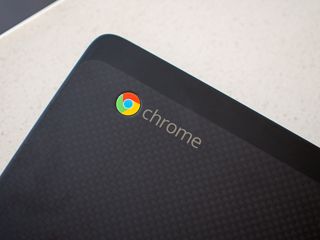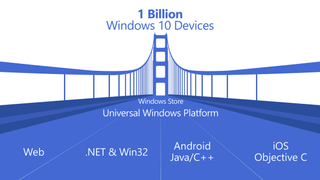Why Microsoft should be worried about Android apps on Chrome OS

Google this week is holding their big I/O conference. Much like Microsoft's Build Google uses the event to talk about the future of its various – and increasingly divergent – product lines (See Google I/O 2016 Day 2: Everything you need to know).
Perhaps the biggest announcement that may affect Microsoft is the impending ability for users to run Android apps on Chrome OS. Considering there are over a million Android apps available that is a huge windfall for a cloud OS like Chrome, which up until now didn't have any apps.
We have talked about convergence before in computing and Google is approaching it from the other end when compared to Microsoft. So, does Microsoft now have something to be worried about? Yes, the do.
The rise of Chrome OS…in schools
Tech enthusiasts and consumers have mostly ignored Google's Chrome OS, but that is slowly changing. More importantly, the biggest area in which Google is having success with Chrome OS is with schools.
The reason for the rise is precisely because the OS cannot install apps and IT departments can lockdown and secure Chromebooks with ease, especially compared to Windows. Sure, Windows can do – way more – but Chromebooks offers school districts a cheap and efficient way to meet basic computing needs on a budget. In the US, where school districts are already under tremendous pressure from an electorate uninterested in infrastructure, Chrome OS is hard to shrug off.
To put all of this in perspective, more Chromebooks were sold in the first quarter of 2016 than all of Apple's OS X, at least according to IDC. A firm number would be close to 2 million units sold. That's the first time such a feat has happened and ignoring Chrome OS is no longer feasible.
Chromebooks outsold Macs last quarter for the first time
The longer term story is more dangerous for Microsoft. By reaching so many children early on with Chrome OS and hooking them on Google's services, or at least familiarizing them with the tech, Google is slowly cornering a new generation of converts.
Get the Windows Central Newsletter
All the latest news, reviews, and guides for Windows and Xbox diehards.
A lot of people use Windows today because it is what they always used. More often than not your first computer was a Windows device, but now that is changing with declining PC sales and the slow rise of Chromebooks. And let's face it, Microsoft has lost the youth market for smartphones, which is the one area in computing that is doing well these days.
Android apps on Chrome OS
Google announced that later in 2016 people will be able to run full Android apps on their Chromebooks (specifically, these). It will all be done through the addition of the Google Play Store to those devices, although schools can opt-out by not letting that happen keeping that market safe for now. Ars Technica does a very good job of explaining how Google achieved this feat and it's worth a read.

The main takeaway is that developers will not have to do much to get their apps onto Chrome OS. Those apps run through containers and offer split-view and floating window app sizes instead of any awkward stretching. More tools for developers will be arriving with Android N this summer.
Considering there are 1.5 million Android apps now available including a vast array of popular games like Clash of Clans and Google has pulled off a novel trick without any severe shakeup for developers.
The "It's not a laptop" laptop problem
While all of this Android and Chrome OS stuff is impressive, there are still some perception issues that Google faces. Ironically, Google has the same problem that Microsoft has with Continuum, but from the other end.
For example, the beautiful new $600 HP Chromebook 13 looks like a full PC, feels like a full PC, but it's not a real PC. Just like how Microsoft's Continuum looks like full Windows 10, but it cannot run "classic" Win32 applications either. (However, virtualization may be the solution for both platforms.)

For some people, this won't be a problem. Modern mobile computing is going towards the app model, which even Microsoft is mimicking with its Universal Windows Platform (UWP). However, a Windows 10 two-in-one or even low-cost PC still can run Photoshop, full Office, any web browser you want, iTunes, or any application your company wants you to use. Plus you now have Windows Ink, which is aiding the smart pen resurgence.
Chromebooks can't do any of that and won't be able to either. There is also the lack of security for enterprise. So, the question is Do people still want that ability to run classic, full desktop applications? If so, spending $400 or more on a Chromebook will be an issue. It's a great device until you need more and if you do need more are you going to carry around two devices?
Do people still want that ability to run classic, full desktop apps?
On the flip side, if people can just use a Chromebook with Android apps then you cannot really criticize Microsoft's UWP initiative and Continuum. The one hole, however, in that argument is a big one. Google has 1.5 million Android apps and Microsoft, well, does not. Not yet, at least.
In some ways, Google here was smarter. It's easier to go from a mobile environment up to devices with larger displays than to take a legacy OS and fit it to mobile. Luckily for Microsoft, they already did the heavy lifting and Windows 10 and OneCore is basically done. Google (and Apple) at some point will need to rectify their multiple operating systems just like Microsoft.
Convergence is real but problematic
Google's move with Android on Chrome OS is momentous, but the company is facing similar market constraints as Microsoft. Consumer interest is shifting, and people want portable computing wherever, whenever with just one device and one experience.
Microsoft is attacking the problem from the desktop to mobile while Google is going from mobile to the desktop. Neither solution is perfect as both companies face significant hurdles to get there. Microsoft has almost no mobile market share, and Google's Chromebooks are just starting to be taken seriously. Google benefits from 1.5 million Android apps, but Microsoft offers the power of full Windows and real desktop applications. Plus, long-term UWP is attractive to developers especially when you throw in Xamarin and Bridges into the mix.
It's hard to say which system will win at this point.
Google does have an upper hand with market momentum, declining Windows PC sales, the rise of ARM, and 84 percent of the mobile OS market. Not to mention their ability to shape the next generation of kids with Chromebooks in schools.

But can Google convert regular consumers and business to Chromebooks and get them to give up real computing? I'm not entirely sure, but I do know Microsoft should be worried. Windows 10 is a bigger paradigm shift, and it can run everywhere – desktop, laptops, tablets, phones, HoloLens, Xbox, IoT – but they are up against a company playing for keeps, and this latest move from Google could undercut what Microsoft is trying to accomplish.
Folks, we're in the middle of the next paradigm shift in technology and things are going to get very interesting in the next two years. Just how Google, Apple, and Microsoft navigate this period and meet consumer demands will be an exciting space to watch. (As a side note, my colleague at Laptop, Mark Spoonauer, came to a similar conclusion).
Who do you think has the advantage? Let us know in comments what you think about the future of computing and which company will get it right.

Daniel Rubino is the Editor-in-chief of Windows Central. He is also the head reviewer, podcast co-host, and analyst. He has been covering Microsoft since 2007, when this site was called WMExperts (and later Windows Phone Central). His interests include Windows, laptops, next-gen computing, and watches. He has been reviewing laptops since 2015 and is particularly fond of 2-in-1 convertibles, ARM processors, new form factors, and thin-and-light PCs. Before all this tech stuff, he worked on a Ph.D. in linguistics, watched people sleep (for medical purposes!), and ran the projectors at movie theaters because it was fun.
